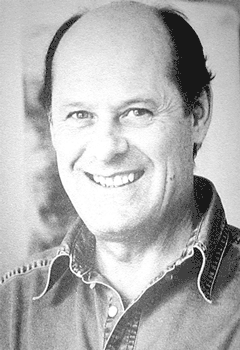| J1 |
|

|
|
Bible by hand - by Nancy Moffett The Chicago Sun Times, Wednesday, March 22, 2000
For the first time since the printing press inherited the job of quill pens, a handwritten version of the Bible is in the works, one that will shine with illuminations in gold, silver and platinum and sparkle with vermilion and lapis lazuli. "The Bible is the calligraphic artist's supreme challenge, our Sistine Chapel," said Donald Jackson, scribe to Queen Elizabeth II, who was in town Tuesday to explain the $3 million-plus project, commissioned by St. John's Abbey, a Benedictine monastery, and St. John's University, both in Collegeville, Minn. The techniques are traditional, but the intention is modern-and forward-looking. "We expect this Bible to last for centuries and centuries and to stand as a testimony to what people at our point in history thought about scripture and religious art," said St. John's president, Brother Dietrich Reinhart, on Tuesday at the Northern Trust Bank, which planned to introduce clients to Jackson later in the day. "All of this stuff, the ink, the pen, the surface-we're not using it just because it's traditional," Jackson said. "We're using it just like a violinist uses something ot far distant from a cigar box with a piece of wood in it and catgut strung across it." Just as an orchestra uses ancient things and makes music-modern music-out of it, the calligraphy isn't backward looking. "You use those traditional tolls because they feel great," Jackson said. "It's all about the feeling." But the project has taken longer and been harder "than ever would be imagined," Jackson said. "You don't just walk in and start writing," he said. "You're looking at more than a million words of text." Medieval tradition meets the computer age in the six-year project, which stretches scholarship and the imagination from the 21st century back to monks whose meticulous copying was prayer made manifest. Goose quills must be cured, calfskins sanded to make vellum, ink prepared. Jackson found Chinese ink sticks and vermilion blocks that arrived in London 100 years ago for Queen Victoria's "colorman." The Chinese ink is a mixture of soot from gum-rich wood, Jackson said. He loosed a few drops of water onto a black stone and ruffed an ink stick in it to make enough to improvise the headline for this story, using the font he designed. He sharpened a reed, not a goose quill-which will be used for copying the Bible-using a penknife handmade in Minnesota for calligraphers. The blunt-tipped wood handle of the knife is also useful in preparing the point's-it's pushed down into the hollow reed to split it at the point to hold the ink for release onto the writing surface. "We prepare the shins, rule the lines, make sure each of the calligraphers has got the right page and is writing the right text in the right place." The scribes' job is touch-working on vellum that costs $500 a sheet. "You can't tear it up and start again. You've got to let it go," Jackson said. It's important material, but "something that has movement, rhythm and flow." The St. John's Bible comes with a 21st century spin: tight production deadlines, computer technology and TV crews. It also comes with a 21st century sensibility. Science and technology of today's worked will be represented and women will get a more modern treatment. The illumination to go with the opening of the Gospel According to Matthew tells the genealogy of Jesus. Jackson's illustration shows a Jewish menorah as the family tree, surrounded by spirals that suggest DNA chains and names written in Hebrew, Arabic and English. Scholars supplied Jackson with briefs for each illuminated passage to reflect modern scripture interpretations. The briefs even offer advice on particular images. For instance, one suggests a boat to signify the church for the "Calming of the Storm" passage in Matthew (8:23-27). The translation is from the New Revised Standard Version. "We thought long and hard about which we should select," Reinhart said. "The New Revised Standard Version is very deeply faithful to the original languages and the historical context in which those books were written." At the same time, for instance, it corrects past translations that seem to apply only to makes. "It recognizes we have no inclusive work in English for men and women...but that's not the way it was in Greek or Hebrew," which had words for human beings that didn't specify gender, Reinhart said. "I thought I would be irritated by the modernity of the language, but I'm actually enjoying it," Jackson said. As scribe to Her Majesty Queen Elizabeth's Crown Office at the House of Lords, Jackson is responsible for creating official state documents. Plants and animals of Minnesota will show up in the Bible's illuminations, which also will draw from Native American traditions as well as Eastern and Western religious thought. "We feel trapped if we think of the great religious art as only in the past, Reinhart said. Working in a scriptorium in Wales, Jackson's four-person team has begun. A scribe may take three-quarters of an hour to an hour and a half to warm up for the daily transcription. Jackson chose a two-column grid because it's flexible and pages can be divided into halves or quarters. "I have to make a marriage" between words and image, he said. Jackson designed a script for the text, mindful first of legibility. He also worked to balance the lettering with the illuminations and letter height with length of column lines. English words are short and choppy, unlike the long Latin words copied in medieval texts, so to avoid the washed-out look from so many white spaces, he blackened the script. Jackson has worked with serious purpose, using the scholars' briefs with a modern interpretation. "Just as the Earth is not still, neither is scholarship, neither is depth of understanding," Jackson said. He also promises "a few jokes." "There is respect, there's love, there is a lot excitement and zip in it...and there'll be humor, too." he said. The mammoth project from a modern perspective "Has the character of something that is crazy in the wonderful sense; it's so out of our normal expectations that it becomes wonderful by itself," said Paul Gehl, custodian of the John M. Wing Foundation on the History of Printing at the Newberry Library. As a "striking, large and beautiful object, which is essentially a text," the Bible will be exciting because it's a "communicative object" that's "unlike the ones we usually see- Huge billboards, newspapers or mass consumption objects," Gehl said. |
|||||||||||

